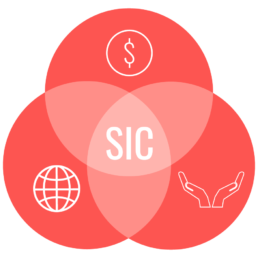A SIC, or a Social Impact Company, is a financially self-sufficient and socially and environmentally responsible company.
Turning one’s company into a SIC will bring about benefits within the company, as well as outside: the staff will be more engaged, customer loyalty will be intensified and the company’s image will be more reassuring. As a consequence, the company will grow faster and more efficiently. Plus, the fact that it is involved at a social and environmental level will reflect well on its actions and good name, raising its position in the public eye.
Most times however, one tends to see as SIC any company that is not SICk: literally “sick”, metaphorically a company that puts profit before the health and wellness of people and the environment. If a company is not SICk, it can simply be a company that does not produce sickness, but neither wellness, and therefore a company that is in the middle and cannot be defined in either way.
Turning one’s company into a SIC is a long and complex journey that can only be taken by following a basic concept called Triple Bottom Line (TBL):

As the chart shows, there are 3 aspects to work on: financial, social and environmental. By balancing the objectives of these three areas, a socially impactful result is obtained.
How can a company create social impact?
There are 5 different ways to go about it.
- Non-profit organisations: these are enterprises whose only goal is for the good of society. Consequently, everything these organisations earn is spent to further their mission.
- B Corps: these are companies with a list of prerequisites necessary to be considered SICs, although it is not their main goal. A requisite is, for example, transparency in identifying and publishing their contribution to society and the environment.
- Mission-First Businesses: these enterprises are oriented towards a socially impactful mission, but unlike non-profit organisations, they generate a profit, and retain their commitment to society as the company’s main goal.
- Socially Responsible Businesses: companies of this sort do not put social and environmental missions in first place, but operate with awareness of the impact they could have, and are concerned about society and the surrounding environment.
- Big donors: instead of working directly in the social or environmental field, some companies decide to fund companies that address these areas directly. They donate a percentage of their earnings to social projects carried out by others.
What really makes a SIC effective, regardless of the type of business referred to?
- To ensure that a SIC works, it is necessary to pick a very generic environmental or social problem and concentrate on it. Over time, an offshoot of that problem may arise that requires closer examination, but that is only possible when starting from broader views.
- Keeping the parts of the TBL chart balanced.
- Focus on a mission and turn it into the point on which to concentrate the attention of the whole company.
We can now conclude with a utilitarian reasoning: running a SIC is a morally noble choice, but not only: with the advent of the digital age and social and environmental changes that we are currently facing, enterprises with a high social impact are the future of commerce, and are destined to grow further, in the financial sense, as well.
SHARE!

